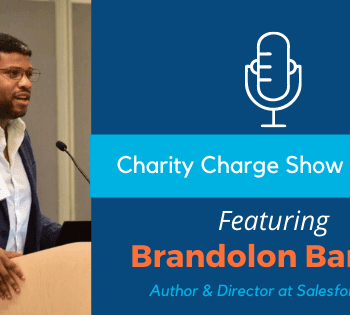In episode 39 of The Charity Charge Show, Stephen Garten chats with Jye Turk, founder of SolvED and Young Nonprofit Professional Network Austin Board Member.
In this post, listen how Jye Turk works to remain fluid and adaptable while administering programs and running a nonprofit organization virtually. SolvED is an equity-centered organization committed to providing access to tutoring services, specifically to students who have been historically underserved by the public education system. At SolvED, Jye recognizes, communicates, and develops the importance of the family’s role in a student’s education; distinguishing between school and education, allowing a more fluid experience for the family and the student.
What is the current state of nonprofits in Austin?
I think being in community is what was at the top of mind for most people by Friday. You know, we tried a lot of online happy hours, a lot of online chats. But what ended up happening was most people were burned out from using the computer and from having really ineffective remote meetings all week. So the temperature kind of changed from Monday to Friday. So I’d say the overall feeling was a lot of uncertainty, especially for nonprofit professionals. It’s kind of like you were saying earlier, a lot of people don’t know where funding is going to come from and a lot of people don’t know how they’re going to remain in service. There’s a lot of uncertainty, a loss of community, and a lot of looking for ways to keep things moving.
Yeah, I will say there’s, I think a lot of people that are starting to grasp that there is not going to be a short term fix and as weird as that sounds, I think that kind of puts people at ease. It’s a problem that we’re kind of all going through and that we’ll have to get through together.
How does working remotely affect the mission of your organization?
The mission of Solved is to reconnect the disconnected. We started really focusing on students last year and that was doing in-home tutoring services. And quickly, we learned that parents really needed to be informed about relevant and current opportunities to help meet the needs of their kids. So fast forward to now, that model is completely busted. There is no at home visiting, until likely for a while. A lot of the students we were serving already had financial gaps to be filled. So in terms of a lack of technology, one of the difficulties we’re seeing is a lack of exposure to how to use technology or parents really having inadequate training on technologies to be able to communicate effectively.
Some of the parents we were working with don’t have the infrastructure to be able to sustain a virtual service. Where we’re at right now is kind of two parts. One, how do we make our same service work just as well, as it’s really about an emotional connection with the kid. How do we do that virtually? So what are some tools we can use for that? And that’s where I’m at right now, in the research phase. What tools can we use? And it’s sort of given me a whole new revenue model as I’m trying to see the positive out of it. I think that operating remotely, although is not the greatest circumstance, it is a reality, I think, would eventually have been faced.
What has been the most challenging aspect of operating an organization remotely?
So we’re taking that on now. How do we access these parents? I already felt disconnected with parents and now they’re literally disconnected from the system. So the question is how do we get some of those skills and technologies to them to keep supporting their students. The biggest crisis right now, for us, is how the disconnect is affecting students that maybe have an ARD that isn’t finished, an Annual Review and Dismissal of their individual education plan in public schools. A student that might’ve been thinking about college and was working really hard with their high school counselor, now doesn’t have access to that person or any school resources whatsoever. So that’s where our focus is really going to shift in the next few months, is supporting students that were working within a system that was kind of just keeping them afloat while they were in school. They don’t have that right now and parents don’t have those resources either. And so that’s where we’re at and that’s where our energy is going to be spent in the next coming months, all the way through August.
How have you adapted to meet the needs of underserved students virtually?
In the short, let’s say schools are closed through the end of the school year. There’s a lot of teachers with a lot of time to help. Ideally, I can find some teachers that are willing to give their time and provide the infrastructure for them to connect with these kids. Providing support for some of the services I was talking about earlier and also helping students finish up projects that are required to graduate high school while helping students fill in the gaps in resources.
One other way we are adapting is through launching a virtual story time program. So think second graders and younger, being read live stories from a Solved tutor. For 45 minutes or an hour, a parent can sit their kid down and have someone read a live story to them, something that they’re probably missing from the elementary school classroom.
Something I hadn’t thought of before, but that makes a lot of sense going forward. And in line with that, other virtual services, like webinars, that mimic the feel of a classroom experience and creates a sense of community for kids across every grade level. We have some pretty good tools for creating that sort of a virtual community in a small group of maybe 10 or so. I think keeping the community sort of classroom feel for kids is going to be really important. And that’s something that we have that’s brand new, like 24 hours old or so at this point. And I think that from the top, that’s going to be the big shift.
Featured photo by Megan Markham





